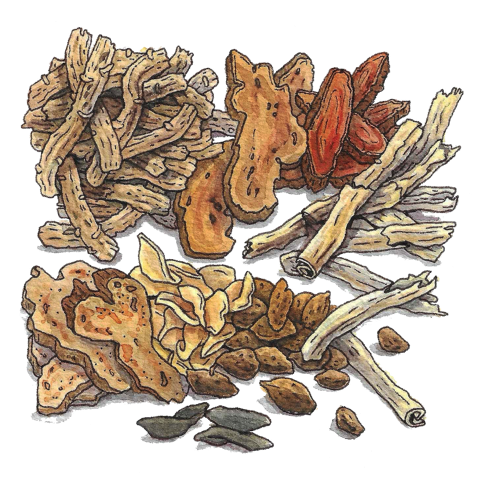
Common Names
- Kousha Rikkunshi To
- Hyangsayukgunja-Tang
- Six Gentlemen Decoction with Aucklandia and Amomum
For Patients & Caregivers
Tell your healthcare providers about any dietary supplements you’re taking, such as herbs, vitamins, minerals, and natural or home remedies. This will help them manage your care and keep you safe.
What is it?
Xiang Sha Liu Jun Zi Tang (XSLJZT) is a traditional Chinese medicine (TCM) formula. It’s made up of 8 different herbs.
What are the potential uses and benefits?
Xiang Sha Liu Jun Zi Tang is used to:
- Treat indigestion
- Treat gastritis (when your stomach lining gets red and swollen)
Talk with your healthcare providers before taking herbal formulas. They can interact with some medications and affect how they work. For more information, read the “What else do I need to know?” section below.
What are the side effects?
Side effects of XSLJZT may include:
- Bloating
- Abdominal pain
- Nausea (feeling like you’re going to throw up)
- Vomiting (throwing up)
- Constipation (having fewer bowel movements than usual)
- Loss of appetite
- Diarrhea (loose or watery bowel movements)
- Dry mouth
- Weakness
- Dizziness
- Rash
- Headache
What else do I need to know?
- Stop taking XSLJZT at least one week before surgery. It may increase your risk of bleeding.
For Healthcare Professionals
Clinical Summary
Xiang Sha Liu Jun Zi Tang (XSLJZT) is a traditional Chinese medicine (TCM) formula with a centuries-long history of use as a treatment for vomiting, gastric fullness, and symptoms and signs of gastrointestinal disturbance. Described in the TCM classical text Gu Jin Ming Yi Fang Lun (TCM Prescriptions by Ancient and Modern Well-Known Physicians), XSLJZT consists of eight herbs: Ren Shen (Panax ginseng C. A. Mey. Radix et Rhizoma.), Fu Ling (Poria cocos (Schw.) Wolf), Bai Zhu (Atractylodis Macrocephalae Rhizoma), Chen Pi (Citri Reticulatae Pericarpium), Ban Xia (Pinellia ternata (Thunb.) Breit. Rhizoma), Gan Cao (Glycyrrhiza uralensis Fisch. Radix et Rhizoma), Mu Xiang(Aucklandia lappa Decne. Radix), and Sha Ren (Amomum villosum Lour. Amomi Fructus). The formula continues to be widely used in China for treating gastrointestinal discomfort (2) (3).
Xiang Sha Liu Jun Zi Tang has largely been studied in Asian populations. In an RCT of adults with irritable bowel syndrome (IBS), XSLJZT affected significant reductions in diarrhea (13). A modified XSLJZT formula was also effective in the management of functional dyspepsia, especially in patients with postprandial fullness and bloating, early satiety, and epigastric pain (12). In another study, XSLJZT improved symptoms of decreased digestive function including fatigue, poor appetite, abdominal distention and loose stools in convalescent patients infected with COVID-19 (11).
Systematic reviews/meta-analyses determined that both XSLJZT and modified XSLJZT are more effective in treating functional dyspepsia and diabetic gastroparesis than prokinetic agents (1) (2) (3) (5). Additionally, the combination of XSLJZT with conventional therapy was found superior to conventional therapy alone or other TCM combinations against H. pylori-associated disease (4) (6).
Larger, well-designed trials are needed to expand the evidence surrounding XSLJZT and to determine its efficacy in diverse populations.
Purported Uses and Benefits
- Indigestion
- Gastritis
Mechanism of Action
Pharmacological studies indicate that XSLJZT restores mitochondrial function and energy supply in the gastrointestinal system, improves motility, regulates inflammatory pathways, and up-regulates the brain-gut axis via increasing production of neuropeptides such as ghrelin, cholecystokinin, and vasoactive intestinal polypeptide (9) (10) (14) (15) (16). XSLJZT may also have potential benefits against gastric cancer and Crohn’s disease by inhibiting inflammatory response and regulating various signaling pathways (7) (8).
Warnings
- XSLJZT contains Ren Shen (Asian Ginseng) and should therefore be discontinued at least one week prior to surgery.